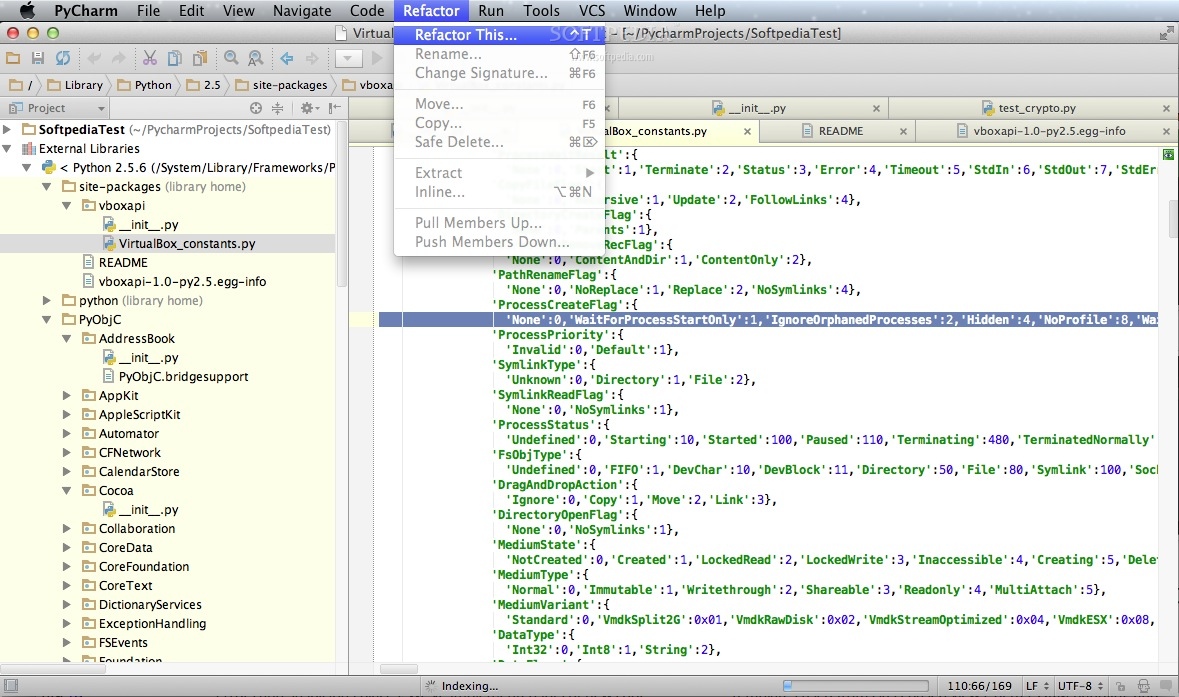PyCharm comes in three editions: PyCharm Edu is free and for educational purposes.; PyCharm Community is free as well and intended for pure Python development.; PyCharm Professional is paid, has everything the Community edition has and also is very well suited for Web and Scientific development with support for such frameworks as Django and Flask, Database and SQL, and scientific tools. Can I use PyCharm Community Edition at work? You are allowed to use PyCharm Community Edition for commercial use. Can I use PyCharm Community Edition at my university? However, you may be interested in learning about our free all product pack licenses for educational usage. Could I fork PyCharm?
PyQt5 is a toolkit for creating Python GUI applications. As a cross-platform toolkit, PyQt can run on all major operating systems (Unix, Windows (Mac).
This article describes how to install Python + PyCharm + PyQt5.
- Current community. How to change keyboard shortcuts for Pycharm on Mac. Ask Question Asked today. Viewed 7 times -1.
- How to install PyCharm Community Edition on your Mac OS X. How to install PyCharm Community Edition on your Mac OS X.
- PyCharm is the most popular IDE used for Python scripting language. This chapter will give you an introduction to PyCharm and explains its features. PyCharm offers some of the best features to its users and developers in the following aspects: Code completion and inspection Advanced debugging.
With PyQt5, the GUI is designed in two ways:
- directly using the code to design the interface
- using QtDesigner to visualize the design, and then convert the resulting .ui file into a .py file.
Related course: Create Desktop Apps with Python PyQt5
Install Python + PyCharm + PyQt5.
Step 1. Install Python.
Visit the official website at https://www.python.org/ to download and install your target Python version.
Install PyQt5
Enter the cmd interface. Run the command and wait a moment.
The command is executed and PyQt5 is installed.
Test if pqyt5 is actually installed
Create a new file, example.py, and enter the following code.
After running, the following screen will pop up, indicating that PyQt is working normally.
3. Install PyCharm.
Visit the official website http://www.jetbrains.com/pycharm/
Choose download and install Community version.
PyCharm Basic Configuration.
Step 1 Create a new project
Step 2 Set the default PyCharm parser.
Select File | Settings | Project: first | Project Interpreter, set Project Interpreter to The version of python you are using
Step 3 Adding third-party libraries
Stay in the Project Interpreter interface, click on the +, find and install pyqt5. pyqt5-sip, pyqt5-tools. After successful installation, the interface should look like this.
Install Pycharm Community Edition
Step 4 Configuring QtDesigner
Install designer
You can start designer directly from PyCharm. Make sure designer is installed first. Designer is not installed with the pip installation.
On Fedora Linux you can do this:
Ubuntu Linux users can do thiS:
You can also do this:
Once qt5-designer is installed, you can configure it in PyCharm.
PyCharm select File | Settings | Tools | PyCharm. External Tools, click + New Tools, Create QTdesigner and PyUIC tools
Configure two key parameters.
Program: the path to your own
designer.Windows users can link to
designer.exe, for exampleC:xxxxAppDataLocalProgramsPythonPython35-32Libsite-packagespyqt5-toolsdesigner.exeFedora Linux users can link
designer-qt5Ubuntu users can set it to
/usr/lib/x86_64-linux-gnu/qt5/bin/designer
Pycharm Community For Mac
- Working directory:
$ProjectFileDir$
Step 5: Configure PyUIC
Configure three key parameters.
- Program: Your own
python.exepath For example,C:xxxxAppDataLocalProgramsPythonPython35-32python.
- Arguments:
-m PyQt5.uic.pyuic $FileName$ -o $FileNameWithoutExtension$.py
- Working directory:
$ProjectFileDir$
You may like: Create Desktop Apps with Python PyQt5
Test PyQt installation
From code
Now that everything is setup, it’s time to test if everything is setup correctly.
Create a GUI interface using the code below (or any PyQt code).
Select Run->Run first. You should see a PyQt window popup.
QTDesigner
Use QTDesigner to generate a GUI interface and convert it to a .py file using PyUIC.
Select Tools->ExternalTools->QTdesigner.
In the QT Designer interface, a GUI creation interface will pop up for the first time, click on create to automatically generate a GUI interface.

Save the interface as Untitled.ui file.
Back to the PyCharm project interface, there is an extra .ui file under the project list.
Right-click on Untitled.ui and select ExternalTools->PyUIC in the pop-up list.
This will generate a Untitled.py file for Untitled.ui.
